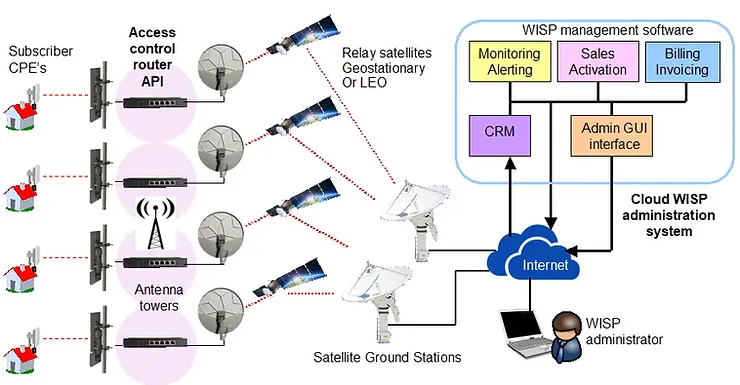Almost all WISP networks are built with the centralized model for the reason that a wholesale ISP provides a high capacity data connection at one location and the WISP has to build out the network from that point. The WISP's area of coverage is restricted to areas where wholesale ISP’s can provide backhaul connections.

In some parts of the world there are no wholesale ISP's and WISP's are backhauling their PtMP towers into DSL circuits when available or geo-stationary satellite circuits such as those provided by #HughesNet in areas of the world where this service is available. Consequently the quality of service provided to customers is extremely variable, however customers who want Internet access in some parts of the world have no other alternative than to use poor quality services. Many large areas of the earth have no Internet service, as there is no access to an Internet backbone connection.
WISP's will soon have the opportunity to provide Internet services in areas where it is not possible today. The introduction of low earth orbit (LEO) #satellite Internet services will permit tower backhaul connections at any point on the earth, and not limited to the locations with a copper or fiber cable. People in many parts of the world cannot afford the cost of LEO satellite services but the performance of the service is sufficient to provide a WISP tower backhaul into the Internet. The #WISP can divide the LEO satellite cost between many people so that the service becomes affordable for each customer. A new generation of WISP's will start in business to provide Internet for locations where the Internet service is currently not possible due to the lack of any type of backhaul connection to the Internet backbone.
LEO satellite antennas can be installed on each PtMP tower and each LEO antenna will provide the backhaul bandwidth for a group of customers. Multiple LEO satellite #antennas cannot be installed at the NOC because several LEO antennas grouped together would share the bandwidth from one satellite, which gives no throughput advantage. However when LEO antennas are installed on towers spaced by several Km apart each LEO antenna will communicate with a different satellite.
When LEO satellite services finally become widely available in an enterprise service form that permits WISP’s to resell the service then existing WISP’s can switch to distributed #network designs and new WISP’s will start with distributed designs.
The distributed access control network design is illustrated in the figure.

A WISP can begin the process now of upgrading the network to be ready for LEO antennas. The change requires moving the large access control router out of the NOC and installing smaller access control routers at each tower for those customers that are accessing that tower. For the WISP who is configuring the central access control router manually then having access control routers at each tower will represent an additional workload.
There are cloud WISP management systems like easyWISP (www.easywisp.com) that can interface with multiple access control routers and so the WISP might consider migrating the business management to such a cloud system.
A table is included to illustrate the differences between centralized and distributed network implementations.

______________________________________________________________________
Readers are invited to share this information with others. If any reader has a question regarding this information please contact us via our contact page.
